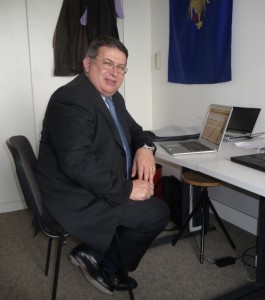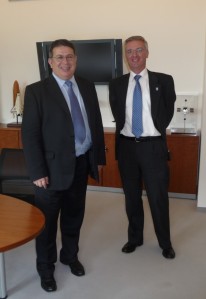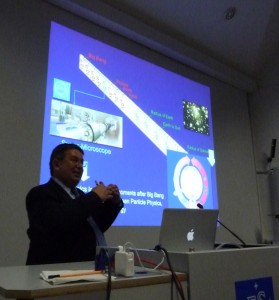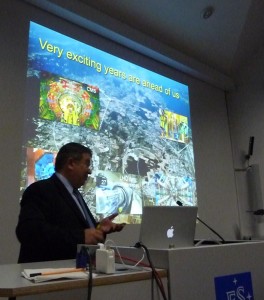CERN’s Director for Science at ESO: an outlook of LHC

Sergio Bertolucci, Director for Research at CERN, comes to ESO to talk about LHC
April 30, 2009
Herschel and Planck ready for launch in two days!
May 12, 2009As I had announced in my previous post, last Tuesday there were great expectations here at ESO for the arrival of Prof. Sergio Bertolucci, CERN‘s Director for Science, who had accepted to give a talk on the Large Hadron Collider.
So, Tuesday morning I was waiting to welcome him (and I was a bit nervous, I must say). I knew his flight was expected to land around 10, so that he would be arriving at ESO Headquarters around ten to eleven. After a while I decided not to wait for the call of the receptionist and I went down the stairs, toward ESO’s main entrance.
And there he was. The night before I had the most dreadful nightmares about him being a terrible guy, that would be asking me questions about quantum mechanics and particle physics all day long. And what was most scary was that I was sure I’d have no answers to those questions… So, you can imagine my relief when he shook my hand and just said “I’m Sergio. Nice to meet you!”. You know those times when you immediately feel comfortable with somebody… that was the case with Prof. Bertolucci. Or, I’d better say, with Sergio. It did not take very long to be impressed by him. And it was not just because I knew who he was, but because of the very fact he actually was absolutely not showing it. That made my day and all the tension I had accumulated vanished in a few minutes. After chatting a bit, the secretary of ESO’s Director General phoned us. The DG was ready to receive Sergio for a brief meeting in his office. As I mentioned in my previous post, CERN and ESO are two big European organizations, working at the two extremes of a very long path, that goes all the way from the dimensions of the visible universe to the subnuclear scales. They might seem totally unrelated, but they actually both try to answer some very fundamental questions.
When the meeting was over we went out to the ESO terrace and we had quite a long chat about physics, experiments, students, careers in science, the prospects of nuclear energy and so on. Clearly Sergio does not take himself very seriously and, of course, this makes him an even more fascinating person. An then, you know, it is the kind of people he interacts with that contributes to make the difference. During the discussion he was mentioning several times a guy called Carlo. Sure enough Carlo is quite a common name in Italy. But after a while I realized he was referring to a particular one. Well, yes, Carlo Rubbia, of course. Sergio commented that Carlo [Rubbia] is extremely fast in his reasonings and that it takes quite a bit of an effort to follow his intuitions and scientific visions.
And then other big names came out during the very pleasant discussion. For instance that of Peter Higgs, of whom Sergio told me he has a photo in his office. If the LHC proves the existence of the Higgs boson (sometimes called the “God Particle”), then Peter Higgs might well be awarded the Nobel Prize (he made a joke on the fact that he [Sergio] has seen already at least one Higgs, and that is Peter Higgs ;-). Or Gerard ‘t Hooft, who already got the Nobel Prize in 1999. You can imagine how my self-esteem was going down by the minute. I remember the first time I saw Galileo’s Cathedra in Padua. Newton had said he was standing on the giant’s shoulders. Well, I felt like being under the giant’s shoes… But I was relieved by the amusing aneddocts Sergio was telling me, about life at Fermilab (Chicago), experiments in the Gran Sasso labs and stuff like that. All first hand science…
Time was running fast and so, at some point, we went back to my office, where Sergio refined a few details in his presentation. Then we joined my colleague and good friend Martino Romaniello for an entertaining lunch at the Max Planck Canteen (here at the Garching campus everything speaks about physics. Besides streets dedicated to the most famous scientists, there is one which is called Coulomb Wall…). Sergio had spent a couple of years in Hamburg, working at the DESY experiment. So he was familiar with German food and he did not show any doubt (or emotion) while choosing in the menu of the day. Among other things, during lunch he made a quite strong prediction about one of the results which will come out of the LHC. But I will not reveal it here… He also told us about all the trouble caused by the alarms on the possible formation of mini blackholes at LHC. These were picked up by media an spread as a wildfire all over the world. CERN had to put together a team of top scientists to demonstrate this was nonsense. And what was more challenging, he said, is that they had to convince people who did not understand a word about physics. But the most impressive (and visionary) statement was about the science which will come out from LHC. “The collider has been built to test predictions of the current standard model. But it is not so much this that intrigues me. It is more the unexpected things that LHC will probably reveal that will open new paths to modern physics”.
After a coffee, we go to the ESO Auditorium to set up the presentation. Everything is ready and a few people are already showing up. We had advertised the event quite a bit, involving all physics institutes in the Garching area, the University in Munich and the Excellence Cluster. So a large number of participants was expected. After a while I start fearing actually too many… as is typical of scientific seminars, scientists show up on the last minute, with their cups of coffee or tea. And this one made no exception.
A few minutes before 15 the all seats were occupied and the back row was starting to fill with standing people. A few minutes after 15 the auditorium was packed, with some 120 participants. It was finally time to start. I picked up my bell (as I usually do when starting talks at ESO) and I rung it. The room went suddently silent. “It is a pleasure and a great honor to introduce today’s speaker, prof. Sergio Bertolucci. He has started his career in physics with a thesis on the search for vector muons at the Scuola Normale Superiore di Pisa, back in 1975…”. And so on. For several minutes I listed the various achievements of Sergio’s career, until I reached his current appointment as Director for Science and Scientific Computing at CERN. Then I finally gave the floor to Sergio.
The presentation was very fluid and delivered with a typical Italian style, enthusiastic, passionated, interspersed with jokes and pervaded by lots of humor. Despite of the fact he was talking of what is most likely the most challenging scientific enterprise mankind has ever undertaken. Amazing. A twenty seven kilometers ring of superconducting material, cooled at 1.8 degrees Kelvin (which means very close to the absolute zero). When the whole thing is cooled down from ambient temperature to the operational temperature (and that takes months), the length of the ring shrinks by eight meters… Certainly LHC is a collection of big numbers, starting with that of people working for it. Including the four experiments this adds up to more than 10,000 people. When the proton beam circulates in the ring – Sergio said – it is like having a TGV train at full speed. Or, if you wish, like an airplane carrier at 12 knots. If you loose control of the beam, this would simply destroy the machine… Clearly, this experiment is going to change physics. Maybe this is why about a billion people watched the first beam production (September 10, 2008) which was broad casted live by BBC. He spent quite some time in describing the September 18th accident, that has caused some delay in the originally planned schedule. I will not go into the details here, but his description made it very clear to the audience that the thing is damn complicated. “When the LHC project was kicked off” – he said -“it was based on not-yet-existing technology. It was based on hope…”. It looks like that hope has come true, in the end.
The September accident has allowed them to develop more sophisticated checks on the health of the machine and it will certainly contribute to prevent other possible failures in the future. The LHC is supposed to go back into full operation by the end of the year. From time to time I was turning to look at the audience’s reaction. I could see lots of astonished faces. And we are talking about experienced physicists. Here and there I could see the key people involved in the European Extremely Large Telescope, which is going to be the biggest telescope on earth, with a diameter of 42 meters. People that had made the ESO Very Large Telescope working, which is still the biggest optical-near IR astronomical facility on the planet. Nevertheless they all appeared thrilled. The last slide had a title which summarized all the spirit that pervaded Sergio’s presentation: “Very exciting years are ahead of us”. Indeed, we are all looking forward to the first LHC results.
There were loooots of questions, that ranged from technical to physical. And I could not help asking one myself. “As you know,
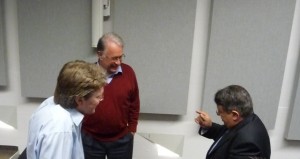
Bruno Leibundgut, ESO Director for Science (left), Wolfgang Hillebrandt, former director of the Max Planck Institute for Astrophysics (center) and Sergio Bertolucci.
we are using quite a bit of dark matter in astrophysics. Do we have any hope that you will finally tell us what dark matter is?”. “Well” – he joked – “I thought you (meaning the astronomical community) were going to tell us!” (the whole audience laughs. It actually did this many times during the talk). But then he went on mentioning WIMPS, super-simmetry and other exotic stuff I spare you here. Other questions followed and a few other people approached the speaker after the seminar was over. But Sergio’s day at ESO was not over yet. The last item on the agenda we had prepared for him was a meeting with Bruno Leibundgut, Director for Science at ESO. Before going up to the fifth floor, where Bruno has his office, we sit for a while in the terrace, chatting about LHC and the astounding things we got to learn during the talk. A cold wind is blowing from the north, reminding us that Spring comes late in Munich.
At 17:30 a taxi picks up Sergio and carries him to the airport. A memorable day comes to its end. Arrivederci, Sergio!

